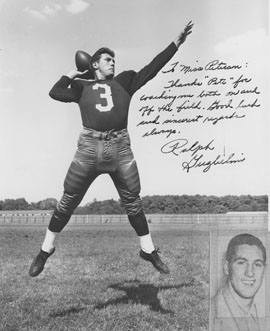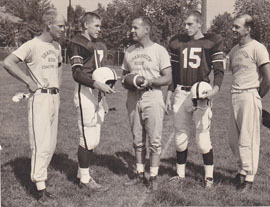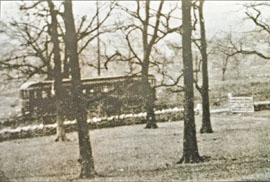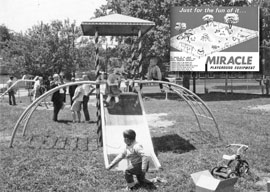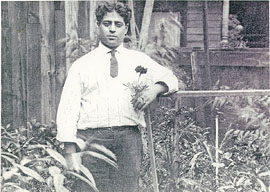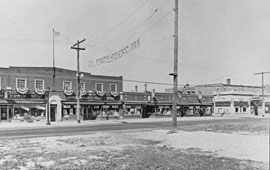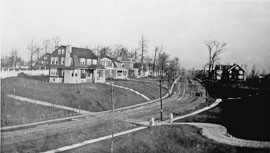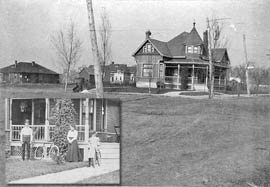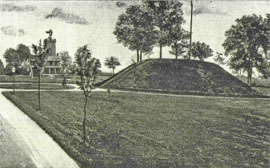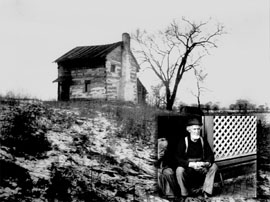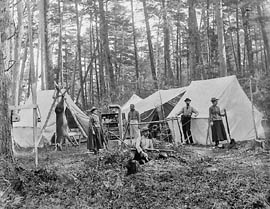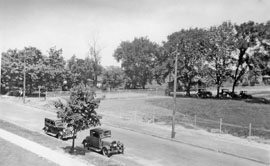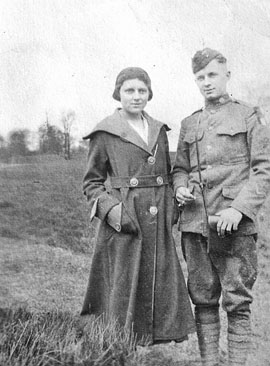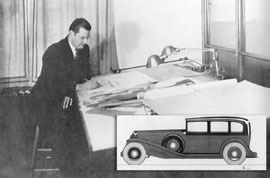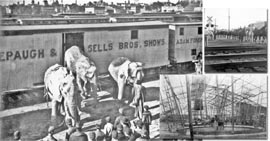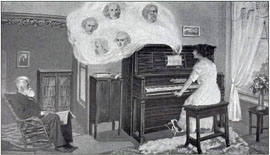Grandview Heights High School graduate and College Football Hall of Fame member Ralph Guglielmi passed away on Monday, January 23rd. Guglielmi, who lived on Thomas Road and graduated from GHHS in 1951, was a 4-year, 3-sport letterman (he was all-CBL for two years in basketball), and was an honor student who also participated in other school activities. After graduation from Grandview, he went to college at Notre Dame, where he played quarterback for the Fighting Irish and earned all-American honors. He was 4th in voting for the Heisman trophy in 1954. He was drafted in the first round by the Washington Redskins of the National Football League, and he played 66 games in the pros for the Redskins, St. Louis, New York Giants, and ending his career in 1963 at Philadelphia. After his football career, he owned auto dealerships and restaurants in the Baltimore and Washington D.C. area. He retired in 2003 to North Carolina. This photo was signed for Grandview teacher and coach Emily Peterson.
Robin Priday was a longtime coach at Grandview Heights High School, starting in 1954 as assistant to head coach Bob Dudley. The following year, Dudley left Grandview for the college ranks, and Priday took the reins as head coach, and started his career that season with a 9-0 record. Priday had served as a pilot in the second world war, which had interrupted his college football career with Ohio State, under legendary coach Paul Brown. He was on the second team when the Buckeyes won the 1942 national championship, and started as quarterback on the 1945 OSU squad. After graduation, he coached at Mt. Sterling, Wilmington, and Troy before coming to Grandview. He started the track program at GHHS, and retired from coaching in 1966 to become the junior high school principal. He retired from the district in 1980 and was inducted to the GHHS Sports Hall of Fame in 1994. Priday died on the 12th of January at 93 years of age. He is shown in this photo from the 1958-59 yearbook with team captains Bob Foster and Tom Nye, and assistant coaches Richard “Hoppy” Hopkins and Harry Householder.
The Arlington Country Club, located in Marble Cliff, was a 9-hole golf course that had existed since it was established as the Arlington Golf and Riding Club in 1895. Several of the high profile members of the Club wanted to establish an 18-hole course nearby, and the Scioto Country Club was established in 1915 on the grounds of the Miller Farm in what would become Upper Arlington. Members of the newly formed country club travelled by car to the facility, but many relied on public transportation, which was by rail. Two companies served the area: the Columbus, Urbana, and Western Electric Railway operated an “interurban” car from Gay and High downtown, and the Columbus Railway Power and Light in 1917 added service that would stop near the entrance to the club. This photo shows one of the interurban cars on Dublin Pike (Riverside Drive), seen through the trees that lined the entrance to Scioto CC, looking across the stone wall that was built from the quarries just to the east. The quarries were so close that the stone dust often settled on the greens of the golf course.
Lowell Riley began his musical career in 1934, when he started at WBNS Radio. He advanced to Musical Director at the station. Since 1945, he and his wife Beth lived at 1389 Arlington Avenue in Marble Cliff. He served as the choir deirector at First Community Church, and also taught vocal music at Grandview and Arlington High Schools for several years around this time. He was later hired as the full-time organist and music director at First Community, a position he served in until 1971. He was instrumental in many of the choir activities, including the Christmas Eve service, the Cloister Choir, and the Church's Childrens Choir. His daughters were part of that choir. In 1942, he founded Vaud-Villities, which began as a minstrel show with the Men's Glee Club from the Church, followed with the addition of the Cloister Choir the following year. He realized that he needed accompaniment help, so he added Dr. Bob Murphy, who is best known as an Arlington physician who founded the Department of Sports Medicine at Ohio State, where he also served as team physician. Vaud-Villities became very popular, eventually moving downtown to Veterans Memorial Auditorium in 1961. Shown in this photo are the "dual pianos" of Riley (left) and Murphy.
In 1966 the playground across from R.L. Stevenson school was outfitted with new playground equipment. The playground was designed around equipment purchased from the Miracle Playground Equipment Co. out of Grinnel, Iowa (a section of their brochure showing the different equipment and a sample layout is inset.) The playground, named the Kiddie Korral, was the brainchild of Mayor Wyman, and was funded with donations from residents coordinated by the Ohio National Bank on First Avenue. This photo shows Mayor Wyman discussing the installation with some parents, shown behind children playing on the “Jack and Jill” climbing and sliding installation. Other installations in the playground included the Dome Whirl, the Flying Pony swing, and the Mustang Whirl, along with other swings and slides and an all-purpose shelter. This photo is from the center of the playground looking west toward the intersection of Oxley Road and First Avenue, with the school to the right of the scene.
Nicholas Botti (“Nick the Barber”) was born in Rutino, Italy in 1887 and arrived in Columbus, Ohio when he was 16. He initially worked in his sponsor family’s grocery store (he was taken in by the Adorno family, who had lost a son Nicholas), spent time working in the Carmen Spaghetti factory on Goodale., and finally settled on being a barber. His first barbershop was located on Goodale in Flytown, and was known as Nick’s Place. He relocated his family to Grandview Heights and opened The Village Barbershop at 1668 West First Avenue in 1920. His shop occupied the east side of the building , and the west side of his building was leased to various tenants. Botti became a master gardener and maintained a garden to the rear of his barbershop. He was especially renowned for the quality of his strawberries and grapes. Nick Botti died in 1974 at the age of 87. A hair salon directly across from the Grandview Library currently occupies the building that housed his barber shop.
This undated photograph shows the north end of the Grandview Avenue Bank Block, looking southwest from the then vacant east side of Grandview Avenue. The building at the far right, now the home of Cameron Mitchell’s The Avenue Steak Tavern, housed an ice cream store and The New Far East Chinese restaurant. Across the alley, in the space currently occupied by Spagio European & Pacific Rim Cuisine, is Robbins Five and Dime and the Kroger Grocery and Baking Co. Next door to Kroger is another of the grocery chains in the Bank Block, the Great Atlantic and Pacific Tea Company, also known as A&P. A&P offered meat and produce and in 1936 adopted the self-serve supermarket concept. To the south of A&P is the Carl G. Ludwig general store in the space originally occupied by Frank P. Hall Hardware. The street is decorated for the Bank Block Merchants’ Fall Festival, which was held in October each year.
John Buscemi is shown here pouring a Gambrinus draft beer at his bar, Johnnie’s Glenn Avenue Grill in Grandview. Johnnie’s was originally a grocery store, and added a bar/restaurant in an adjacent room when Joseph and Angelina Scono (Sconciafurno) bought it in 1934. Buscemi bought it from the Sconos in 1943, and it has been a neighborhood bar since. His sons John and James bought it in 1960. Gambrinus beer (or Gam beer) was brewed by the August Wagner Breweries at Sycamore and Front in the Brewery District. They operated from the turn of the century until 1974, with Gambrinus, Robin Hood, and Augustiner the three main beers marketed locally.
The development of Grandview Heights and Marble Cliff was enhanced by the trolley system, which allowed riders to come from downtown in just over a quarter of an hour. The trolley ran from downtown Columbus, across the river and west on Goodale Boulevard, heading up Broadview Avenue hill, shown in this c1910 photo, before turning down First Avenue to Arlington Avenue, eventually moving into Upper Arlington. The house in the left foreground (1101 Broadview) was built in 1906 by Claude K. Seibert, an executive with the John Hancock Life Insurance Co. and the 4th Grandview mayor, serving from 1915 to 1919. He also was the president of the Fifth Avenue Floral Co. Next to the Seibert home is the Frank A. Howell home, and next to it is the Dr. George Frankenberg home (his daughter Marie was married to Mr. Howell). The stone pillars in the foreground frame the drive to the Frank Byers Howell family properties, later developed in 1957 by Anthony Amicon as Broadview Terrace. Transcripts of interviews with early Grandview residents indicate that local kids sometimes greased the tracks as a prank so that the trolleys had difficulty climbing the Broadview hill.
As the 19th century drew to a close, the Columbus metropolitan area began taking shape. Along the boundaries of the Columbus corporate limits, the suburbs began to take shape. Between 1885 and 1900, developers had platted 41 subdivisions on the fringes of the city. The 12 subdivisions in the northwest would become part of Marble Cliff (2) and Grandview Heights (10), which would be incorporated in 1901 and 1906, respectively. Nine of the others were part of Bexley and Linden Heights. Through the use of restrictive covenants, the developers selectively restricted land use and raised the standards of real estate by cost and location. Marble Cliff reduced its size by two thirds in 1903, with about half of the detachment becoming the heart of Grandview Heights and the rest going to the county. Grandview annexed additional land in 1911, 1912, and 1922. In 1921, Columbus tried aggressively to capture the subdivisions through annexation, and were rejected at the polls. They tried again in 1931 to annex Grandview, and were again stifled. This 1923 map shows the impact of the split of land from Marble Cliff, as the “finger” of Columbus annexation captured the taxes associated with business development along Fifth Avenue from the Olentangy to the east boundary of Upper Arlington (Marble Cliff and Grandview are shaded gray). In 1956, Grandview annexed 426 acres of township land along Dublin Road on the southeast boundary, adding significantly to the tax base, but the decision was not popular with Columbus city leaders, and the annexation was overturned by the county commissioners the following year.
This April, 1959 photo was taken by the Thomas Engineering and Surveying Co. of the north side of the Village of Marble Cliff. At the far right is the Scioto River, with Dublin Road adjacent to it. The quonset style building fronting the railroad tracks was the Ohio Department of Natural Resources building (just above the Columbia Gas System Service Co. building, now the NiSource Co.) The road running diagonally across the bottom of the photo is Fifth Avenue, and it intersects at the left with Cambridge Boulevard. Trinity United Methodist Church can be seen at that corner. A block west (to the right) is Arlington Avenue. On the west side of Arlington Avenue at Cardigan Road is the former St. Raphael Home for the Aged, which included the Samuel Bush mansion. A condominium development was built on that property, but the Bush mansion was saved and renovated as part of the development. The street to the right of the building is Roxbury, and the Our Lady of Victory Church is seen on that corner. The large mansion below the church, facing the circular driveway, was the Sheldon-Wallick mansion, built by early Marble Cliff resident Butler Sheldon and later owned by the Columbus Deshler Hotel manager Adrian Wallick. The mansion would become part of the Roxbury Arms Apartment complex a few years after this photograph was taken.
This aerial photo was taken in the late 1950s, looking east, and shows the former site of the Aladdin (Arlington) Country Club at the lower right. The club started in 1895 as a riding club, and later developed a 4-hole golf course on the site. It expanded to nine holes and operated until 1925. The clubhouse was located at the base of the curved entrance road. At the left side of the photo is the mansion known as the Casparis Castle. The main Scottish-style house is flanked by a carriage house with a 5-story tower attached. It was built by Marble Cliff resident and Marble Cliff Quarry owner Sylvia Casparis in 1908. The site was developed by Ron Pizzuti as 10 Arlington Place (because the mansion was on Plat #10 of the Arlington Place subdivision) in the early 1980s. The street above the country club site is Arlington Avenue. In the center of the photo on the east side of Arlington Ave. is the complex built by Columbus brewer Carl Hoster, and at the upper right is the sanctuary of First Community Church, before the expansion increased its footprint along Cambridge Blvd.
Dorothy Louise Butterworth is shown with her bicycle near the family home at 1227 Lincoln Road, c1915. Dorothy graduated from Grandview High School in 1917, and from Ohio State in 1922. She was the granddaughter of Henry Butterworth, a prominent Columbus businessman who owned Butterworth and Sons and Butterworth Fur Company and lived at the corner of Urlin and Merrick. Her uncle was Frank Butterworth, who built a half dozen residences in Grandview before falling down an elevator shaft and dying (he lived in a home on the southwest corner of First and Lincoln). Dorothy’s father was Charles (wife Louise), who was elected the first Clerk of Grandview in 1906, and was appointed Village Marshal in 1907. Dorothy married Roy Sebring from Genoa Township near Westerville in 1937, and died in 1980.
This Italianate building, with its balustraded balcony above the entrance, was typical of a popular Victorian architectural style of the late 19th century. The building, located on the southeast corner of Fifth and Glenn Avenues was built in 1923 by brothers Nick and Patsy Cenci, and housed their renowned grocery and restaurant. The second floor of the building was a luxurious rental apartment with rich woodwork and Italian-craftsmen carved stone mantels. The first floor was the grocery, and the basement featured a soda-fountain, a lunch room, and the baking facilities. The market was closed in the 1950s, and the building is now the Peking Dynasty restaurant. The Cenci families were very active in the founding of the Our Lady of Victory Church in Marble Cliff.
This panoramic view shows the development and new construction in “Arlington Place” near the northwest corner of Third and Arlington Avenues circa 1896. Utility poles and street signs are evident: however, the streets are unpaved. The home in the center is the Newhouse residence at 2020 West Third. It is flanked by one-story residence at 1492 Roxbury in the background left and 2049 Cardigan in the background center. Clinton Newhouse, his wife Blanche Gray Newhouse, and daughter Marie are shown in the inset. Mr. Newhouse worked for the railroad for 52 years and was Station Master at Marble Cliff at the time of his retirement in 1936. The area has changed significantly during the past 110 years. “Arlington Place” evolved into the Village of Marble Cliff. Fortunately all three homes have survived.
Grandview Heights children play a game of horseshoes on the playground east of R.L. Stevenson Elementary School in this circa 1935 photograph. The school opened in 1926, and the city-owned land on the east side of Oxley Road was designated as a public park and playground. It was later named Pierce Field in honor of Grandview's eighth mayor. Behind the kids is the newly opened strip shopping center anchored on the east end by Geiger's Market. McKinley Drugs (lower right), which also contained a popular soda fountain, was later a tenant of the center. The school is shown in the background of the photo taken from Geiger's Market in 1935 in the upper right. The north and south classroom wings were added to the main building in 1930.
For centuries Indian tribes buried their dead and associated artifacts in large above ground sites, known as "mounds." Two of these mounds were located close to Grandview Heights and Marble Cliff - the Shrum Mound on McKinley near Trabue Road, and the Toepfner Mound, shown in this 1892 photo. This 30 feet high, 165 feet in diameter mound was located near the intersection of Grandview Avenue and Dublin Road, and was the burial site of the Adena Indians. Radiocarbon dating has set the date of the establishment of the mound at 410 BC, and the artifacts have been associated with the early to middle woodland period of archaeology, representing over 85 burials in an estimated 600 year timeframe. The Mound was on the property of landowner W.A. Anderson, who sold it to W.A. Pope (whose home is shown in the background) in 1888. The land was purchased in 1946 by Studebaker dealer Joseph Toepfner, who attempted to bulldoze the site for a truck repair shop. His attempts were blocked for 7 years by local residents until 1953, when the Ohio Historical Society agreed to excavate it. Dr. Ray Baby of Ohio State University supervised the dig, and built a temporary structure over the excavation to keep the weather out. Many artifacts are on display at OHS.
In 1927 Frank Nugent Freeman published a collection of books entitled "Correlated Handwriting", published by Columbus based Zaner-Bloser Publishing Company. An image in one of the books in the series showed a classroom setting in which the materials associated with the handwriting program were demonstrated. The classroom in the photograph was one of the classrooms in R.L. Stevenson Elementary School in Grandview, shown in this 1929 photo. The labels in the photo refer to the Correlated Handwriting Compendium, the Zaner-Bloser Penholder, the Teachers' Manual, the Penmanship Strip, and a student using the Handwriting Scale, all components of the Correlated Handwriting program.
Daniel Thomas (lower right) arrived in 1844 to the area that would become Grandview Heights, and discovered this cabin. Located between the Olentangy River and what is now Northwest Boulevard, the cabin was covered in climbing vines with mud filler for the crudely hewn logs, according to a 1908 article in the Ohio State Journal. Thomas lived in the cabin for fifteen years while farming the area between Goodale Boulevard and 3rd Avenue, vacating it after he built a large farmhouse and barn nearby. It remained empty for several decades until his grandson, James O. Thomas moved into it in 1890. James Thomas, the father of Caroline Thomas Harnsberger who was recently honored with admission to the GHHS Alumni Hall of Fame, lived there until he moved into his new house on the hill near Goodale on the west side of Northwest Blvd. He and his family farmed there until the entire farm was sold in 1916 to the Northwest Boulevard Company for subdivision into lots for homes. The original Thomas home at 789 Northwest Boulevard was razed over twenty years ago to build The Grand View of Columbus Condominiums.
The rustic hunting campsite photograph was provided by the granddaughter of George Urlin, Grandview Heights entrepeneur and pioneering developer. Urlin and his business associates were responsible for laying out the plan for much of what would become the original Grandview village. George is reclining in the foreground with his dog and shotgun and his wife Alice is standing on the left with her gun. The other individuals are not identified, but the man wearing an apron standing near the camp stove is assumed to be a domestic. The large hanging buck waiting to be dressed suggests that Mr. Urlin was a serious hunter as well as businessman. The location and date of the photograph are not known but presumed to date prior to 1900.
Gutches Grandview Market was one of many neighborhood grocery stores located around Grandview Heights and Marble Cliff. It was located at the corner of First Avenue and Oakland in the former Celeste Realty building, which was recently razed to build condominiums. The building later housed Gaudieri's Cleaners and Tailor Shop, and for a short time housed the Grandview Public Library. This early photo shows Mr. Gutches in his delivery car, and a sign in the window advertising Furnas Ice Cream. The Furnas Ice Cream Co. was started in Indiana, and later partnered with Velvet and the Borden Co.
This undated photograph is taken looking northwest from the Grandview Heights High School, which was opened in the fall of 1923. It shows students lounging at their cars parked near the site of the current concession stand at the south end of the stadium at the intersection of Third and North Star Avenues. At the time this photograph was taken there was no stadium, no track, nor tennis courts (the stadium was built as a WPA Project and dedicated in 1938.) Over the next ten years, whenever the opportunity arose, the Board of Education methodically bought parcels of land north of the school to accommodate the expanding sports programs.
Ralph Karns is shown with his future wife, Laura Walcutt. The two school sweethearts (they were in the same class all through school) were married in 1922. Laura lived in the family home on the hill at 1800 Goodale Blvd. Laura Walcutt Karns wrote about her home and many of her experiences in the house, and her writings are featured as the first installment in a new series that the Historical Society is calling "Grandview Reminiscences", which will periodically include a new feature on their website. You can read articles about the Karns, Laura's writings, and newspaper articles and see photos of them at http://www.ghmchs.org/memory.html Several others are currently on the site, and future installments will be announced in this Moment in Time column.
Alan H. Leamy was born in Maryland in 1902, and moved to Grandview in 1905 when his father assumed the position of District Manager of the Welsbach Co. which manufactured gas mantels. Alan was fascinated with automobile designs, and at the age of 25 became a stylist for the Marmon Motor Co. in Indianapolis. He later became the chief stylist for Cord/Duesenberg, designing America's first front wheel drive car, the 1929 Cord L-29. Three of his trademark designs, the graceful radiator shell, the artistic hood and the sweeping clamshell fender extending into the running board, were evident in the design of the famous Duesenberg Model J, the 1931 Auburn 8-98, and the LaSalle and Cadillac (inset), designed just before Leamy became the chief stylist at the LaSalle division of GM in 1934. Leamy died at age 33 of septicemia from a medical procedure.
The September, 1921 Norwester (inset lower right) depicted a Curtiss JN-4D biplane flying over the countryside. The "Jenny", as the plane was known, was one of the most popular airplanes of all time, serving as a World War I trainer (90% of the pilots received their training in the Jenny) and later sold as surplus in the civilian market. This photo was taken in 1921 at the landing field at King Avenue just west of North Star. The Jenny in the photo was owned by R. S. Haines, who was the Ohio representative for the surplus disposal of these aircraft. It was used to take local residents on thrill rides, which for $10 consisted of a flight north along the Scioto, then west and south over Olentangy Park and past the University, then over Grandview and Marble Cliff before landing. Plans were drawn to expand the landing field on King Ave. to accommodate the 122th Aero Squadron of the National Guard, but were never were implemented.
The Sells Brothers Circus was started in 1871 in Columbus. After the first show at State and High Street, they purchased the first of many elephants, which became the main attraction for their circus. By 1890 it was the second largest in the United States, and gained notoriety for the use of railroad cars to transport the animals from location to location (at one point in their history they used 47 railroad cars to transport the circus.) In 1896 James Bailey purchased part ownership in the Sells Circus, which wintered in Sellsville, just north of Grandview, and renamed it the Adam Forepaugh and Sells Brothers Shows . This 1901 photo shows the bull elephants being offloaded from one of the rail cars. In 1906 the entire circus was sold to the Ringling Brothers. The bottom right photo shows the raising of one of the big-tops in 1906, and the upper right shows horses from the Ringling Brothers circus crossing the railroad at Grandview Avenue on the way from the train cars to the show in 1950.
This drawing from c1916 shows a young woman at a Lindenberg player piano, with images of various composers drifting in a cloud and an appreciative gentleman listening to the sound generated from the paper rolls. The Lindenberg Piano Company was founded as the Columbus Piano Company by Charles Lindenberg, whose Broad Street home (designed by architect Frank Packard) later became the Ohio Governor’s mansion. His son, Grandview resident Paul Lindenberg, was a 1903 graduate of Yale University, and assumed the presidency of his father’s business shortly after graduation. It was renamed the Lindenberg Piano Company in 1915, and specialized in mail-order player pianos. The firm built higher quality pianos and player pianos under the names of Lindenberg, Columbus, Wondertone, Convertola, Columbia, and Boudoir at their plant at the corner of Buttles and Michigan Avenue in Victorian Village. A fire damaged the plant in 1918, and they relocated to Gift and Culbertson in the Hilltop. Customers could buy the pianos by mail order, and they were then shipped directly to the purchaser at no charge.
